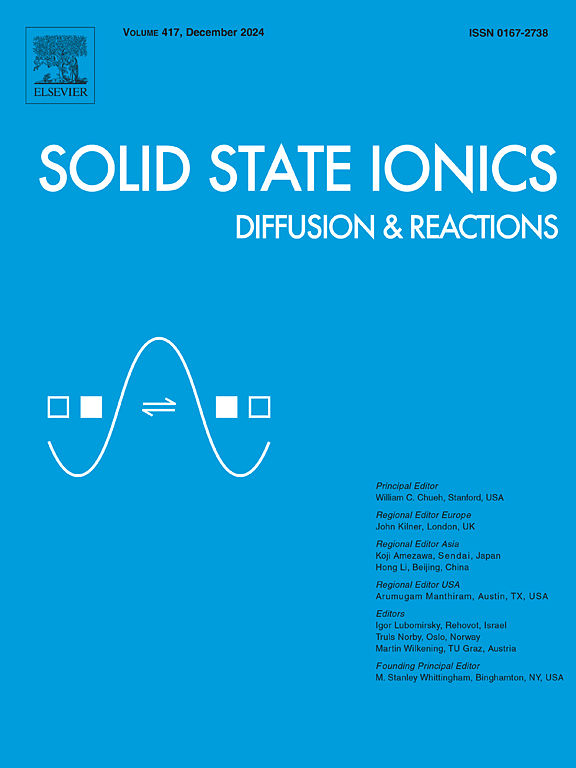锂在固体三元聚合物离子液体电解质中的扩散和转移之间的权衡
IF 3
4区 材料科学
Q3 CHEMISTRY, PHYSICAL
引用次数: 0
摘要
对于需要具有良好接触性能和高抗电化学氧化稳定性的固体离子导体的电池结构,聚合离子液体(PIL)是一类有价值的材料。使用三元离子液体作为增塑剂,可以提高二元PIL/锂盐体系的低电导率。然而,三元体系的导电机理尚不完全清楚。本研究通过增加锂盐浓度,并利用脉冲场梯度(PFG)核磁共振(NMR)、核磁共振弛豫测量、拉曼光谱和电化学技术,将三元Li−/[1,3]PYR-/PDADMA-FSI体系的传递机制与二元离子液体(IL)电解质类似物进行比较,揭示了Li−/[1,3]PYR-/PDADMA-FSI体系的传导机制的转变。发现了两种导电机制,显示了电导率和转移数之间的强烈权衡。在低锂盐状态下(≤35 wt% LiFSI),聚集的锂的簇扩散是导致低迁移数(室温(RT) 0.04-0.15)的主要机制。高盐态(≥50 wt% LiFSI)通过自由锂离子跳跃转移进行扩散,这种转移对温度的依赖性更强,并产生更高的转移数(RT时为0.31)。锂盐浓度的增加与电导率呈线性反比关系。通过改变锂盐的掺量,IL/PIL/锂盐三元体系的电化学特性具有很高的可调性,同时保持了良好的加工性能、稳定性和力学性能。本文章由计算机程序翻译,如有差异,请以英文原文为准。

Trade-off between lithium diffusivity and transference in solid ternary polymer ionic liquid electrolytes
For battery architectures that need a solid ion conductor with good contacting performance and high stability against electrochemical oxidation, polymerized ionic liquids (PIL) pose a valuable class of materials. The low conductivity of the binary PIL/ lithium salt system can be increased using a ternary ionic liquid acting as plasticiser. The conductive mechanism of the ternary system is however not fully understood. This work shows the shift in conduction mechanism for the ternary Li−/[1,3]PYR-/PDADMA-FSI system by increasing the lithium salt concentration and comparing the transfer mechanism to binary ionic liquid (IL) electrolyte analogues using pulsed field gradient (PFG) nuclear magnetic resonance (NMR), NMR relaxometry, Raman spectroscopy and electrochemical techniques. Two conducting regimes were found which show a strong trade-off between conductivity and transference number. In the low lithium salt regime (≤35 wt% LiFSI), cluster diffusion of aggregated lithium is the dominating mechanism leading to low transference numbers (0.04–0.15 at room temperature (RT)). The high salt regime (≥50 wt% LiFSI) shows diffusion through free lithium ion hopping transfer, which has a stronger dependence on temperature and yields higher transference numbers (0.31 at RT). Increasing lithium salt concentration shows an inverse linear correlation with conductivity. The electrochemical characteristics of ternary IL/PIL/lithium salt are shown to be highly tuneable by varying the lithium salt fraction, while it maintains excellent characteristics like processability, stability and mechanical function.
求助全文
通过发布文献求助,成功后即可免费获取论文全文。
去求助
来源期刊

Solid State Ionics
物理-物理:凝聚态物理
CiteScore
6.10
自引率
3.10%
发文量
152
审稿时长
58 days
期刊介绍:
This interdisciplinary journal is devoted to the physics, chemistry and materials science of diffusion, mass transport, and reactivity of solids. The major part of each issue is devoted to articles on:
(i) physics and chemistry of defects in solids;
(ii) reactions in and on solids, e.g. intercalation, corrosion, oxidation, sintering;
(iii) ion transport measurements, mechanisms and theory;
(iv) solid state electrochemistry;
(v) ionically-electronically mixed conducting solids.
Related technological applications are also included, provided their characteristics are interpreted in terms of the basic solid state properties.
Review papers and relevant symposium proceedings are welcome.
 求助内容:
求助内容: 应助结果提醒方式:
应助结果提醒方式:


